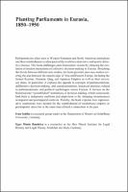Explore

Planting Parliaments in Eurasia, 1850–1950
0 Ungluers have
Faved this Work
Login to Fave
Parliaments are often seen as Western European and North American institutions
and their establishment in other parts of the world as a derivative and mostly defective
process. This book challenges such Eurocentric visions by retracing the evolution
of modern institutions of collective decision-making in Eurasia. Breaching
the divide between different area studies, the book provides nine case studies covering
the area between the eastern edge of Asia and Eastern Europe, including the
former Russian, Ottoman, Qing, and Japanese Empires as well as their successor
states. In particular, it explores the appeals to concepts of parliamentarism,
deliberative decision-making, and constitutionalism; historical practices related
to parliamentarism; and political mythologies across Eurasia. It focuses on the
historical and “reestablished” institutions of decision-making, which consciously
hark back to indigenous traditions and adapt them to the changing circumstances
in imperial and postimperial contexts. Thereby, the book explains how representative
institutions were needed for the establishment of modernized empires or
postimperial states but at the same time offered a connection to the past.
This book is included in DOAB.
Why read this book? Have your say.
You must be logged in to comment.
